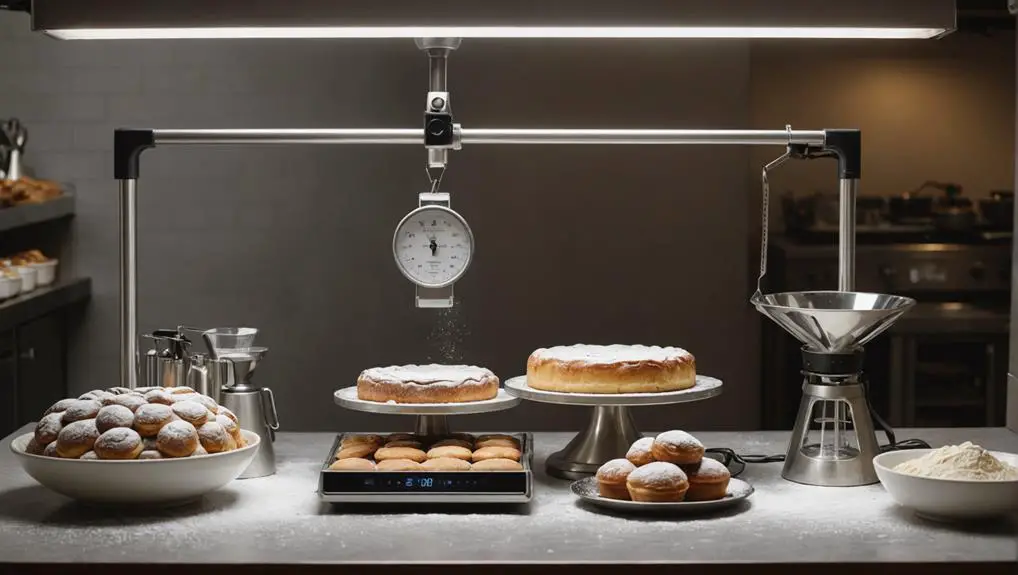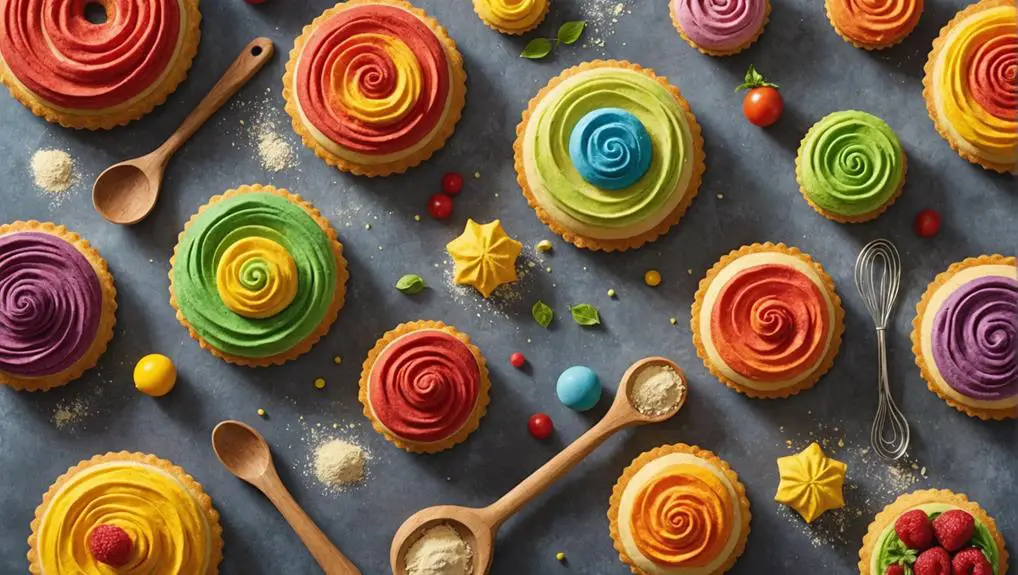In the world of pastry, authentic French creations stand out for their delicate flavors and textures. To achieve these results, one must begin by mastering essential doughs like pâte à choux and pâte brisée. Quality ingredients play an important role, with options like European-style butter and organic eggs making a significant difference. Precision in measurements and oven temperatures shouldn't be overlooked, as these factors can make or break a pastry. Yet, it's the techniques and creativity that truly elevate a pastry from good to extraordinary. The journey to mastery is filled with nuances that can surprise even seasoned bakers.
Quick Takeaways
- Master essential pastry doughs like pâte à choux, pâte brisée, and pâte sucrée for a solid foundation in French pastries.
- Use high-quality ingredients, such as European-style butter and organic eggs, to enhance flavor and texture.
- Ensure precision in baking by measuring ingredients accurately and monitoring oven temperatures with a thermometer.
- Practice key techniques like lamination and piping to achieve the desired texture and presentation in your pastries.
- Embrace creativity by experimenting with seasonal fruits and spices to create unique variations of classic French pastries.
Master Essential Pastry Doughs
Mastering essential pastry doughs is the foundation of creating exquisite French pastries. Each type—pâte à choux, pâte brisée, and pâte sucrée—serves a distinct purpose, elevating the art of pastry-making.
Pâte à choux, an egg-based dough, plays a significant role in crafting airy éclairs and delightful profiteroles. It demands a delicate balance of moisture and fat, ensuring a perfect rise that captivates the palate.
On the other hand, pâte brisée offers a flaky, tender crust, ideal for tarts and quiches. Made with cold, high-quality butter and minimal handling, it retains a light texture that crumbles with every bite. This technique is essential to avoid a dense pastry.
Lastly, pâte sucrée, enriched with sugar and egg yolks, provides a sweet and flavorful base for dessert tarts, harmonizing beautifully with pastry cream.
Understanding the resting and chilling requirements for each dough is crucial for achieving the right consistency and preventing shrinkage during baking. With these techniques, every aspiring pastry chef can create classic French pastries that not only please the eye but also delight the taste buds of those they serve.
Choose Quality Ingredients
Creating exceptional French pastries goes beyond mastering the doughs; it hinges on selecting quality ingredients that enhance every bite. To achieve the perfect balance of flavor and texture, one must choose high-quality butter, preferably European-style, renowned for its rich taste and higher fat content. This choice elevates the overall experience, imparting a luxurious mouthfeel.
Next, unbleached all-purpose flour should be the flour of choice. Its superior protein content contributes to better dough structure and elasticity, resulting in beautifully crafted pastries.
Adding organic eggs not only enriches flavors but also guarantees better emulsification and aeration in batters and creams, making them light and airy.
Incorporating seasonal fruits into recipes can transform pastries, providing fresh, vibrant flavors that resonate with authenticity.
Using low-quality substitutes, like margarine or imitation vanilla, can compromise the integrity of your creations, dulling their taste and texture.
Ensure Precision in Baking

Ensuring precision in baking is essential for achieving the delicate textures and flavors characteristic of French pastries. Accurate measurements play a pivotal role; using a digital scale to weigh ingredients guarantees consistency, which is crucial for perfect pastry doughs.
Oven temperatures must be meticulously monitored with a thermometer, as even a slight variation can drastically affect the rise and texture of pastries.
Timing is equally critical; closely following recommended baking times prevents the pitfalls of overbaking or underbaking, both of which can compromise the final product. Understanding ingredient temperatures is key to success—room temperature eggs and chilled butter directly influence emulsification and the overall quality of the pastry.
Practicing precise techniques, such as gentle folding and thorough whipping, is essential for achieving the desired texture and lightness in pastries.
Each step, from measuring to mixing, must be executed with care, as these elements intertwine to create the exquisite pastries that delight the palate. By honing in on these precision-driven practices, bakers can elevate their creations, ensuring that each bite is a celebration of authenticity and craftsmanship.
Perfect Key Techniques
With a focus on technique, bakers can transform ordinary ingredients into extraordinary French pastries. Mastering lamination is essential, especially for doughs like puff pastry. This technique involves folding layers of cold butter into the dough, requiring at least six folds to achieve that signature flaky texture.
Temperature control is critical; keeping butter cold during lamination prevents it from melting and guarantees distinct layers.
Practicing piping techniques is equally important. Bakers should fill their piping bags only two-thirds full to avoid leaks, allowing for precise shapes and fillings in pastries like éclairs and cream puffs.
When it comes to chocolate, learning the art of tempering ensures a glossy finish and the perfect snap, demanding careful monitoring of temperatures—around 115°F for dark chocolate is ideal.
Lastly, achieving the right meringue consistency is essential. Bakers must aim for stiff peaks for decorations while soft peaks work best for mousses, necessitating careful observation to avoid overmixing.
Embrace Creativity and Innovation

Innovation in French pastry can transform the familiar into the extraordinary. By experimenting with classic recipes, bakers can create delicious French pastries that tantalize the senses. Incorporating seasonal fruits or spices into traditional tarts and éclairs enhances their flavor, showcasing the beauty of creativity in pastry-making.
Utilizing foundational recipes like pâte brisée and pâte à choux as a base opens the door to new variations and personalized interpretations. These easy-to-make doughs are often used in many beloved pastries, offering the best results when paired with imaginative ideas.
Following renowned pastry chefs on social media provides endless inspiration, allowing bakers to explore modern twists on classic creations. Engaging with baking communities, both online and in-person, fosters an exchange of ideas and trends that can invigorate one's baking journey.
Documenting experiments in a baking notebook captures successes and failures, guiding bakers toward refinement and innovation. Ultimately, embracing creativity in French pastry not only elevates the art of baking but also enriches the experience of serving others with unique, memorable treats.
Each pastry can become a canvas for imagination, making every creation a celebration of skill and artistry.
Common Questions
What Makes French Pastries so Good?
French pastries burst with flavor due to high-quality ingredients and meticulous techniques. Their light, flaky textures arise from traditional methods, while seasonal, organic components create unique tastes, making each bite an exquisite experience for those fortunate enough to indulge.
What Is the Golden Rule of Pastry Making?
In pastry making, precision's the golden rule. Just like a skilled musician hitting every note perfectly, accurate measurements and temperatures guarantee harmony in texture and flavor, crafting delightful pastries that leave everyone craving more.
What Are the Three 3 Basic Rules for Pastry Making?
The three basic rules for pastry making involve using quality ingredients, measuring precisely, and controlling temperatures. These principles guarantee the creation of delicate, flavorful pastries that delight and impress everyone fortunate enough to enjoy them.
What Is the Secret to Making Good Pastry?
What's the secret to making good pastry? It's mastering techniques, using high-quality ingredients, and ensuring precision. With practice, one can create textures that delight, leaving everyone keen for another bite of their delicious creations.
Wrapping Up
In the world of French pastries, mastery and creativity dance together, each enhancing the other. While precision in technique and high-quality ingredients lay the foundation, the spirit of innovation breathes life into each creation. As bakers embrace the delicate balance between tradition and personal flair, they transform simple doughs into exquisite works of art. Ultimately, it's this fusion of skill and imagination that elevates pastries from mere treats to unforgettable experiences, inviting all to savor the passion behind every bite.